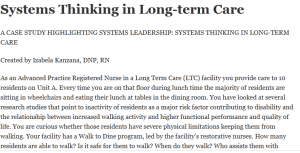Systems Thinking in Long-term Care

A CASE STUDY HIGHLIGHTING SYSTEMS LEADERSHIP: SYSTEMS THINKING IN LONG-TERM CARE
Created by Izabela Kanzana, DNP, RN
As an Advanced Practice Registered Nurse in a Long Term Care (LTC) facility you provide care to 10 residents on Unit A. Every time you are on that floor during lunch time the majority of residents are sitting in wheelchairs and eating their lunch at tables in the dining room. You have looked at several research studies that point to inactivity of residents as a major risk factor contributing to disability and the relationship between increased walking activity and higher functional performance and quality of life. You are curious whether those residents have severe physical limitations keeping them from walking. Your facility has a Walk to Dine program, led by the facility’s restorative nurses. How many residents are able to walk? Is it safe for them to walk? When do they walk? Who assists them with walking? How far do they walk? You are motivated to engage in a project as you have identified an important practice problem. Because the evidence is strong that physical activity is the solution, you know that a QI project to implement the evidence into the process on your unit is the right way to go. The Medical director agrees with you that walking has potential benefits even in LTC.
QUESTIONS
1. Who would be on your QI team? Which members will be the most important to interview?You know that restorative nurses are in charge of Walk to Dine program for residents. You interview restorative nurses and they do not know how many residents are enrolled in Walk to Dine program. They do not know how often residents walk to meals and how far residents walk.
2. What would be helpful baseline data?
3. What might your goals be for your improvement project?
Read the above Case Study: A Case Study Highlighting Systems Leadership and Systems Thinking in LTC, on page 57 in your text, Leadership and systems improvement for the DNP. Armstrong, G., Sables-Baus, S. (2019) Springer Publishing.
Answer the questions (1-3) in an effort to design the QI project.
Searching the Literature
You searched the literature and found strong evidence that walking patients in LTC leads to better outcomes. You also find in the literature search evidence of key implementation strategies that support walking in LTC residents:
• Staff education (Galik et al., 2013; Slaughter & Estabrooks, 2013)
• Monitoring (Slaughter & Estabrooks, 2013)
• Mentoring and motivating (Galik et al., 2013; Taylor et al., 2015)
You contacted your colleague in a different LTC facility and they successfully implemented a walking program designed by the Vanderbilt Center for Quality Aging (Schnelle & Simmons, 2013).
Context for the Improvement:
You assess Unit A’s readiness for a change using the organizational readiness to change survey. To understand the causes of the low participation in the Walk to Dine program, you collect information from all the stakeholders. The following data surfaces:
• Unit A is sometimes understaffed
• CNAs turnover is high
• There is no clear workflow process of walking a resident from an activity to a meal
• There are not enough walkers for residents who can ambulate with a walker
• A third manager was hired within last 2 months and is still getting oriented
• Family members request wheelchairs for residents to take residents to meals
• Many residents have dementia and they tell you they were assisted with walking even though you are told by staff they did not walk
• Two restorative nurses are in charge of the Walk to Dine program in the entire facility (230 beds)
• CNAs think that it is restorative staff function to provide walking activity to residents
• There is no log to track who walks to meals
• No one knows which residents are able to ambulate to meals
• There is no clear process for identification of residents who want to walk to meals
• There is no monitoring in how the residents that ambulate to meals tolerate the ambulation”